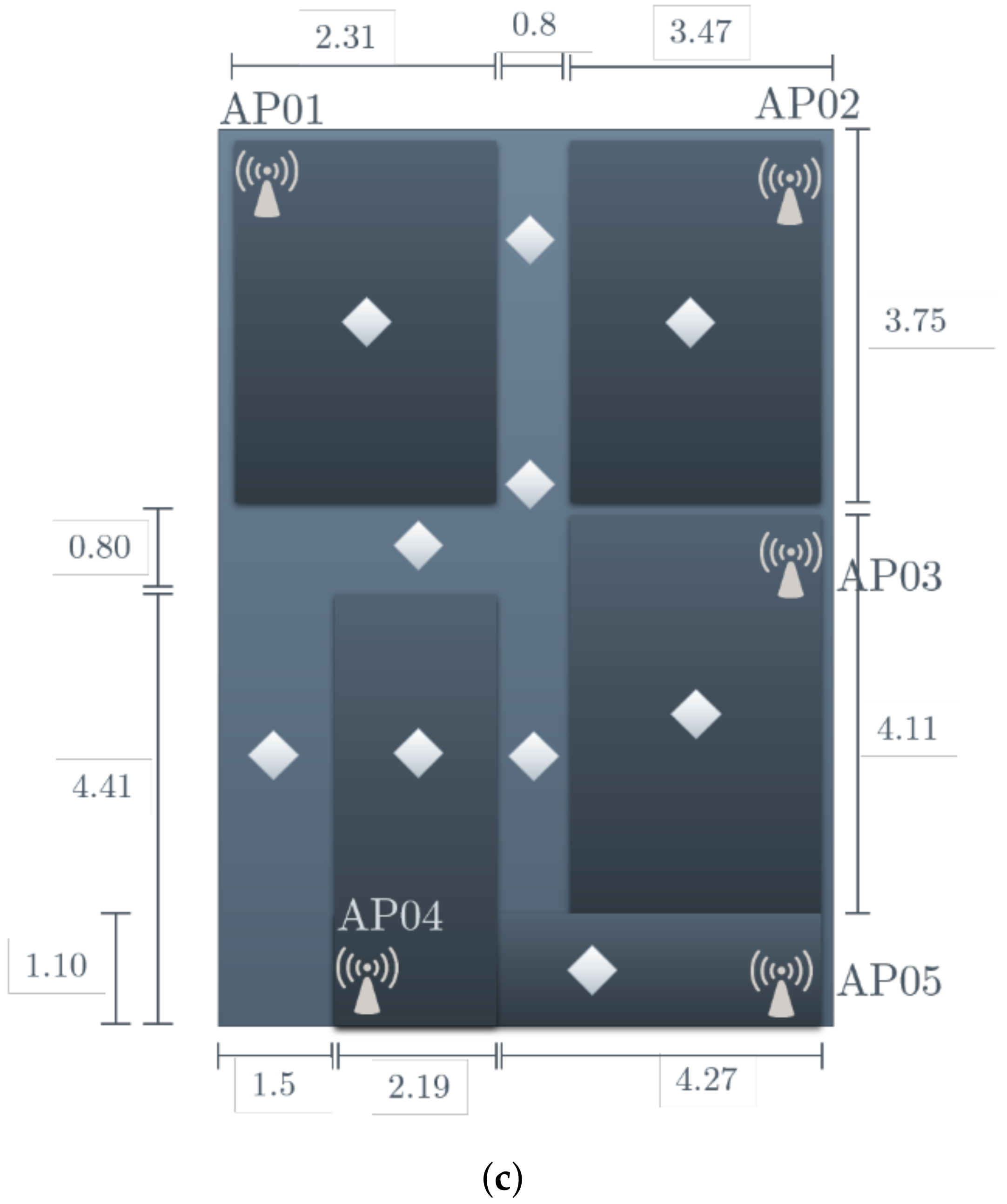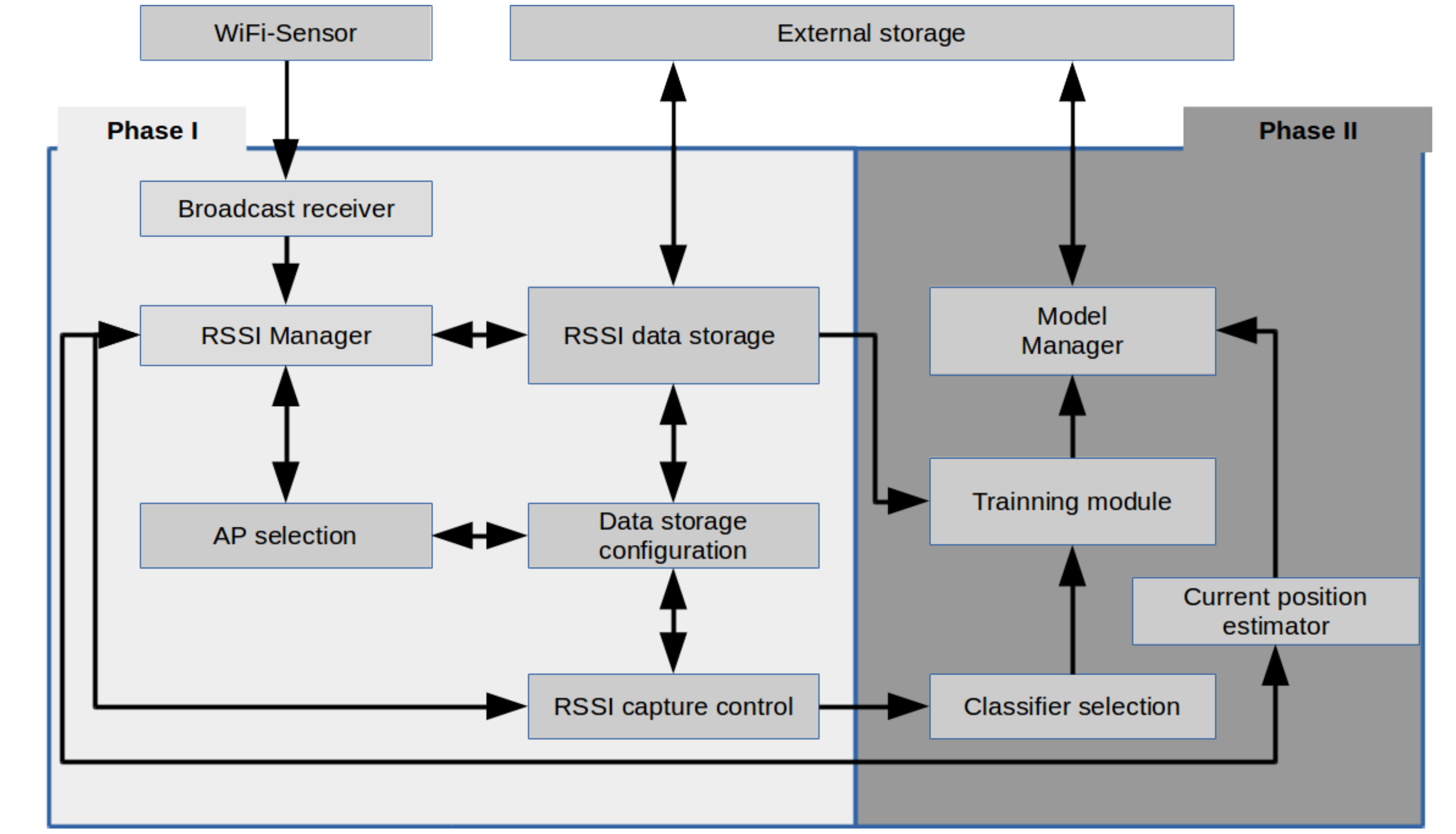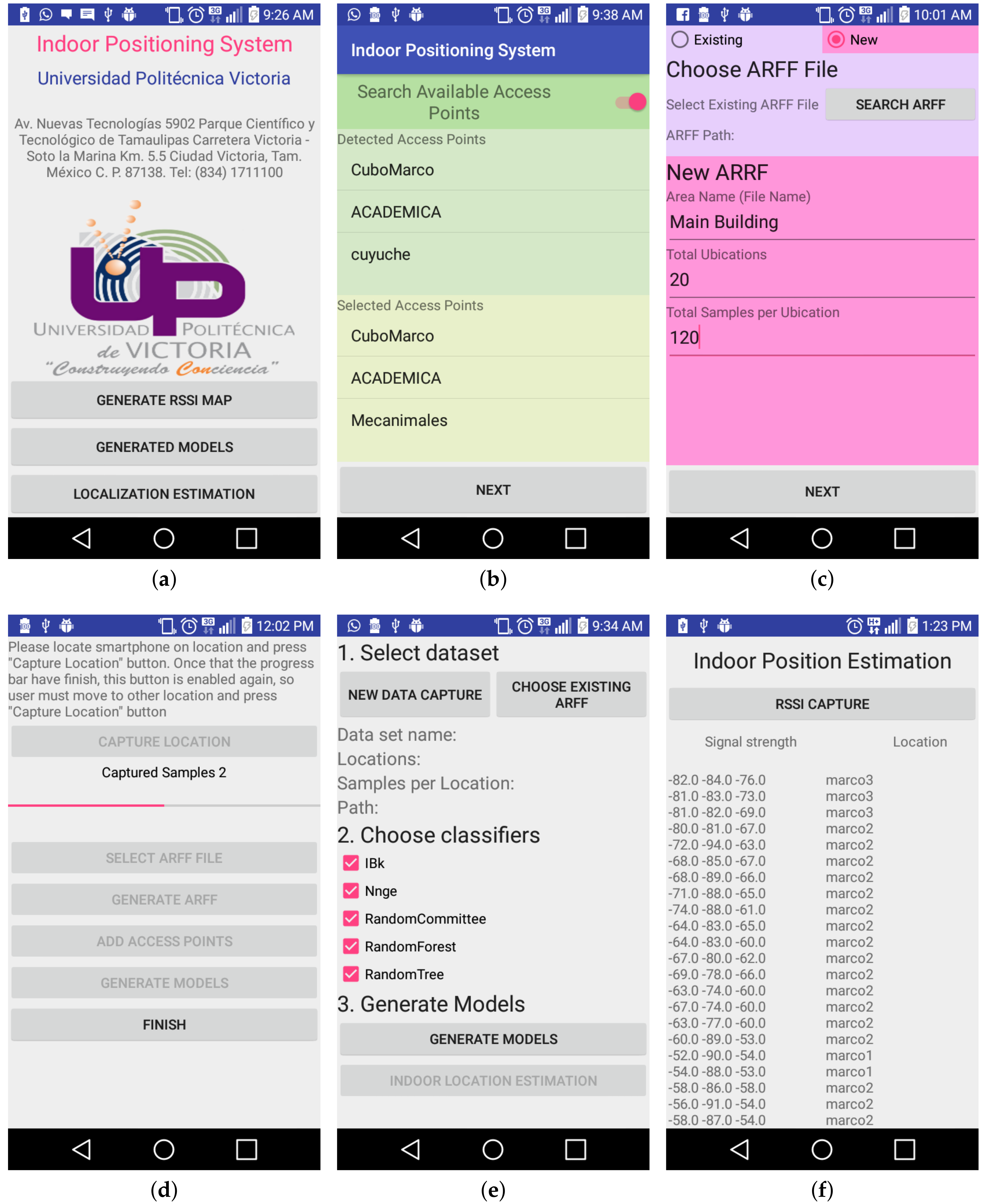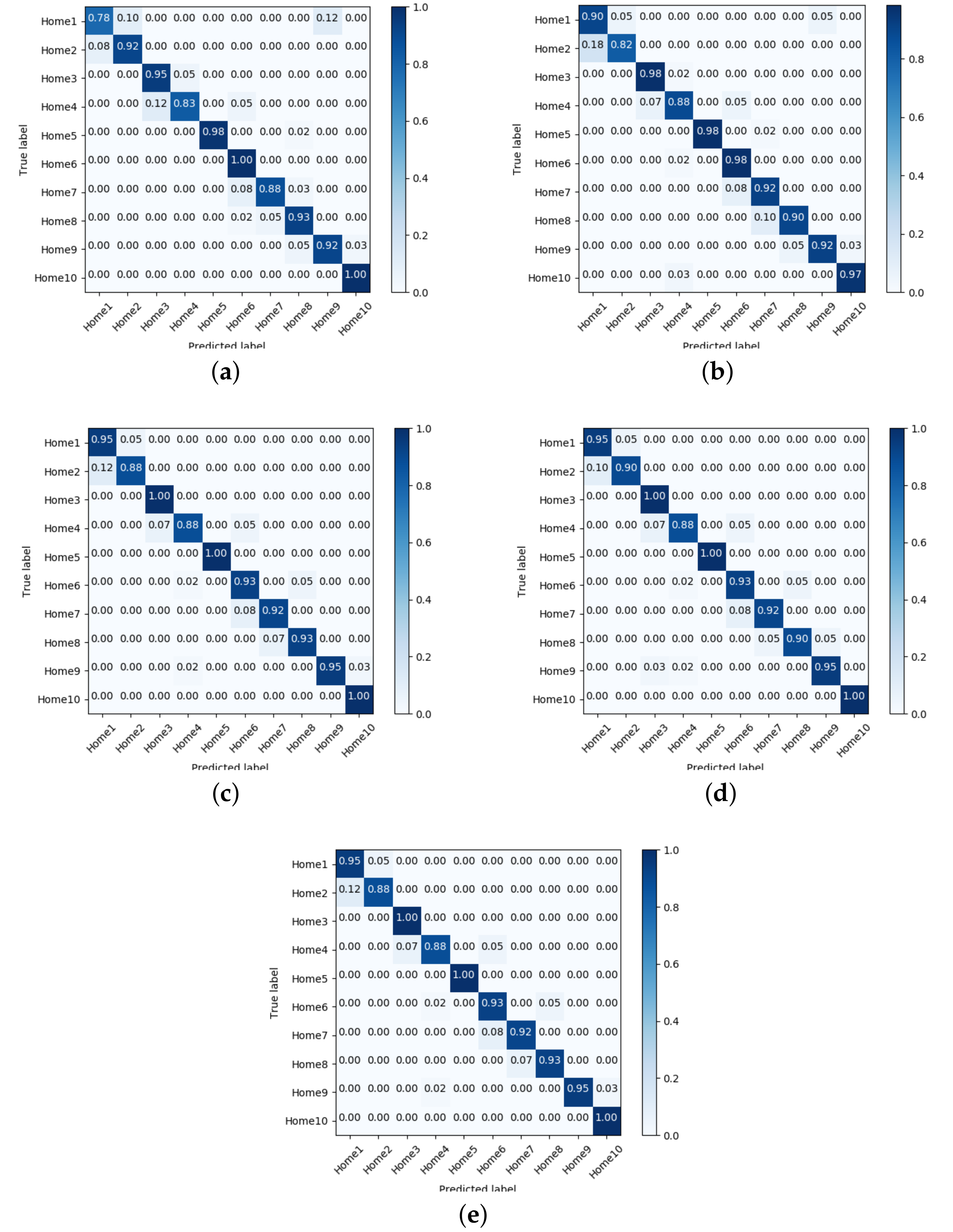On-Device Learning of Indoor Location for WiFi Fingerprint Approach
Abstract
:1. Introduction
2. IPMApp Design
2.1. Proposed Scenarios
2.2. Modules of the Proposed IPMApp
- Broadcast Receiver (BR): This module interfaces directly with the WiFi adapter, in order to determine which APs are available and to obtain information of the RSSI of each AP.
- RSSI manager: This module obtains the list of available APs from the BR, and for each one of the detected APs, the signal strength is obtained.
- AP selection: This module allows the user to select which APs will be used to capture a set of lectures. This module sets the value of AP variable depending on the total APs selected by the user.
- Data Storage Configuration (DSC). This module allows the user to configure the number of locations (LO), the number of lectures (LE) and the name of the ARRF file to store the data.
- RSSI data storage: This module allows one to read and write ARRF files to external storage. When the user wants to create a new dataset, this module takes as input the ARRF name provided by the DSC module and creates a file in the device’s external storage. When the capture process finishes, an ARRF file with LO and LE per location, with AP + 1 columns, is generated, where the number of locations is selected by the user in each lecture column representing the signal strength of the each selected AP. When the user wants to load an existing dataset, this module takes as input the ARFF name, reads its contents and generates a data structure available to other modules. This module also performs the format conversion to normalize the received RSSI.
- RSSI capture control. This module allows the user to control when to start the capturing process in each location and generates an auditive signal when the lectures of a specific location have been captured, so the user can move to the following location to continue with the capture process.
- Classifiers’ selection: This module allows the user to select which classifiers are going to be used for generating the models.
- Training module: This module allows the user to start the training process, which generates the models to be used for the indoor localization estimation.
- Module manager: This module creates an appropriate data structure in memory for hosting information about the generated models and manages the saving and loading models from external storage.
- Current position estimator: This module computes the device’s indoor position based on the RSSIs received from the RSSI manager, using the models generated and trained previously by the user.
3. Experimental Setup and Results
3.1. Hardware Tools
- Mobile device with wireless adapter: In this device, the developed application was deployed, and several tests were performed in order to capture datasets for the proposed scenarios, as well as to validate the indoor localization estimation. The proposed application has been validated on smartphone devices with several Android versions. In Table 3, a list of devices and the specifications used for testing and evaluation of the proposed application are shown. The application worked without problems in the listed devices.
- Personal computer for training the models: A desktop computer with an Intel M Quad Processor ([email protected] GHz), 4 GB DDR2 RAM and the Ubuntu 14.01 LTS operating system (64-bit version) was used only in the early stage for the evaluation of all 59 classifiers.
3.2. Software Tools
3.3. Screens of the Developed IPMApp
3.4. Off-Line Classifier Evaluation
4. Conclusions
Author Contributions
Funding
Conflicts of Interest
References
- Liu, H.; Darabi, H.; Banerjee, P.; Liu, J. Survey of Wireless Indoor Positioning Techniques and Systems. IEEE Trans. Syst. Man Cybern. Part C 2007, 37, 1067–1080. [Google Scholar] [CrossRef]
- Hossain, A.M.; Soh, W.S. A survey of calibration-free indoor positioning systems. Comput. Commun. 2015, 66, 1–13. [Google Scholar] [CrossRef]
- Xia, S.; Liu, Y.; Yuan, G.; Zhu, M.; Wang, Z. Indoor Fingerprint Positioning Based on WiFi: An Overview. ISPRS Int. J. Geo-Inf. 2017, 6, 135. [Google Scholar] [CrossRef]
- Kul, G.; Özyer, T.; Tavli, B. IEEE 802.11 WLAN based Real Time Indoor Positioning: Literature Survey and Experimental Investigations. Procedia Comput. Sci. 2014, 34, 157–164. [Google Scholar] [CrossRef]
- Xiao, J.; Zhou, Z.; Yi, Y.; Ni, L.M. A Survey on Wireless Indoor Localization from the Device Perspective. ACM Comput. Surv. 2016, 49, 25. [Google Scholar] [CrossRef]
- Zeinalipour-Yazti, D.; Laoudias, C.; Georgiou, K.; Chatzimilioudis, G. Internet-based Indoor Navigation Services. IEEE Internet Comput. 2017, 21, 54–63. [Google Scholar] [CrossRef]
- Indoor Atlas Ltd. Last Meter Accuracy through Technology Fusion. Available online: http://www.indooratlas.com/positioning-technology/ (accessed on 25 May 2018).
- Galván-Tejada, C.E.; García-Vázquez, J.P.; Brena, R.F. Magnetic Field Feature Extraction and Selection for Indoor Location Estimation. Sensors 2014, 14, 11001–11015. [Google Scholar] [CrossRef] [PubMed] [Green Version]
- Dortz, N.L.; Gain, F.; Zetterberg, P. WiFi fingerprint indoor positioning system using probability distribution comparison. In Proceedings of the 2012 IEEE International Conference on Acoustics, Speech and Signal Processing (ICASSP), Kyoto, Japan, 25–30 March 2012; pp. 2301–2304. [Google Scholar]
- Bagosi, T.; Baruch, Z. Indoor localization by WiFi. In Proceedings of the 2011 IEEE 7th International Conference on Intelligent Computer Communication and Processing, Cluj-Napoca, Romania, 25–27 August 2011; pp. 449–452. [Google Scholar]
- Mcgibney, A.; Beder, C.; Klepal, M. MapUme: Smartphone Localisation as a Service A cloud based architecture for providing indoor localisation services. In Proceedings of the International Conference on Indoor Positioning and Indoor Navigation, Sydney, Australia, 13–15 November 2012. [Google Scholar]
- Cheng, Y.C.; Chawathe, Y.; LaMarca, A.; Krumm, J. Accuracy Characterization for Metropolitan-scale WiFi Localization. In Proceedings of the 3rd International Conference on Mobile Systems, Applications, and Services (MobiSys ’05), Seattle, WA, USA, 6–8 June 2005; ACM: New York, NY, USA, 2005; pp. 233–245. [Google Scholar]
- Roos, T.; Myllymäki, P.; Tirri, H.; Misikangas, P.; Sievänen, J. A Probabilistic Approach to WLAN User Location Estimation. Int. J. Wirel. Inf. Netw. 2002, 9, 155–164. [Google Scholar] [CrossRef]
- Dinh-Van, N.; Nashashibi, F.; Thanh-Huong, N.; Castelli, E. Indoor Intelligent Vehicle localization using WiFi received signal strength indicator. In Proceedings of the 2017 IEEE MTT-S International Conference on Microwaves for Intelligent Mobility (ICMIM), Nagoya, Japan, 19–21 March 2017; pp. 33–36. [Google Scholar]
- Hernández, N.; Alonso, J.M.; Ocaña, M. Fuzzy classifier ensembles for hierarchical WiFi-based semantic indoor localization. Expert Syst. Appl. 2017, 90, 394–404. [Google Scholar] [CrossRef]
- Trawiński, K.; Alonso, J.M.; Hernández, N. A multiclassifier approach for topology-based WiFi indoor localization. Soft Comput. 2013, 17, 1817–1831. [Google Scholar] [CrossRef]
- Cheng, Y.K.; Chou, H.J.; Chang, R.Y. Machine-Learning Indoor Localization with Access Point Selection and Signal Strength Reconstruction. In Proceedings of the 2016 IEEE 83rd Vehicular Technology Conference (VTC Spring), Nanjing, China, 15–18 May 2016; pp. 1–5. [Google Scholar]
- Nguyen, K.A. A performance guaranteed indoor positioning system using conformal prediction and the WiFi signal strength. J. Inf. Telecommun. 2017, 1, 41–65. [Google Scholar] [CrossRef] [Green Version]
- Werb, J.; Lanzl, C. Designing a positioning system for finding things and people indoors. IEEE Spect. 1998, 35, 71–78. [Google Scholar] [CrossRef]
- Barsocchi, P.; Crivello, A.; Rosa, D.L.; Palumbo, F. A multisource and multivariate dataset for indoor localization methods based on WLAN and geo-magnetic field fingerprinting. In Proceedings of the 2016 International Conference on Indoor Positioning and Indoor Navigation (IPIN), Alcala de Henares, Spain, 4–7 October 2016; pp. 1–8. [Google Scholar]
- Laoudias, C.; Larkou, G.; Li, C.L.; Tsai, Y.K.; Zeinalipour-Yazti, D.; Panayiotou, C.G. Accurate Multi-Sensor Localization on Android Devices. Available online: https://www.microsoft.com/en-us/research/wp-content/uploads/2013/09/loc_competition_claoudias.pdf (accessed on 15 June 2018).
- Bahl, P.; Padmanabhan, V.N. RADAR: An in-building RF-based user location and tracking system. In Proceedings of the IEEE INFOCOM 2000. Conference on Computer Communications. Nineteenth Annual Joint Conference of the IEEE Computer and Communications Societies (Cat. No. 00CH37064), Tel Aviv, Israel, 26–30 March 2000; Volume 2, pp. 775–784. [Google Scholar]
- He, S.; Chan, S.H.G. INTRI: Contour-Based Trilateration for Indoor Fingerprint-Based Localization. IEEE Trans. Mob. Comput. 2017, 16, 1676–1690. [Google Scholar] [CrossRef]
- Torres-Sospedra, J.; Montoliu, R.; Martínez-Usó, A.; Avariento, J.P.; Arnau, T.J.; Benedito-Bordonau, M.; Huerta, J. UJIIndoorLoc: A new multi-building and multi-floor database for WLAN fingerprint-based indoor localization problems. In Proceedings of the 2014 International Conference on Indoor Positioning and Indoor Navigation (IPIN), Busan, Korea, 27–30 October 2014; pp. 261–270. [Google Scholar]
- Huang, Q.; Zhang, Y.; Ge, Z.; Lu, C. Refining WiFi Based Indoor Localization with Li-Fi Assisted Model Calibration in Smart Buildings. In Proceedings of the International Conference on Computing in Civil and Building Engineering, Osaka, Japan, 6–8 July 2016; pp. 1358–1365. [Google Scholar]
- Huang, Q.; Lu, C.; Chen, K. Chapter 11—Smart Building Applications and Information System Hardware Co-Design. In Big Data Analytics for Sensor-Network Collected Intelligence; Hsu, H.H., Chang, C.Y., Hsu, C.H., Eds.; Intelligent Data-Centric Systems, Academic Press: Cambridge, MA, USA, 2017; pp. 225–240. [Google Scholar]
- Hernández, N.; Ocaña, M.; Alonso, J.M.; Kim, E. Continuous Space Estimation: Increasing WiFi-Based Indoor Localization Resolution without Increasing the Site-Survey Effort. Sensors 2017, 17, 147. [Google Scholar] [CrossRef] [PubMed]
- Li, C.; Xu, Q.; Gong, Z.; Zheng, R. TuRF: Fast data collection for fingerprint-based indoor localization. In Proceedings of the 2017 International Conference on Indoor Positioning and Indoor Navigation (IPIN), Sapporo, Japan, 18–21 September 2017; pp. 1–8. [Google Scholar]
- Bâce, M.; Pignolet, Y.A. Lightweight Indoor Localization System. In Proceedings of the 2015 8th IFIP Wireless and Mobile Networking Conference (WMNC), Munich, Germany, 5–7 October 2015; pp. 160–167. [Google Scholar]
- Song, C.; Wang, J. WLAN Fingerprint Indoor Positioning Strategy Based on Implicit Crowdsourcing and Semi-Supervised Learning. ISPRS Int. J. Geo-Inf. 2017, 6, 356. [Google Scholar] [CrossRef]
- Gaber, H.; Marey, M.; Amin, S.; Tolba, M.F. Localization and Mapping for Indoor Navigation: Survey. In Handbook of Research on Machine Learning Innovations and Trends; Hassanien, A.E., Gaber, T., Eds.; IGI Global: Hershey, PA, USA, 2017; Chapter 7; pp. 136–160. [Google Scholar]
- Herranz, F.; Llamazares, A.; Molinos, E.; Ocaña, M.; Sotelo, M.A. WiFi SLAM algorithms: An experimental comparison. Robotica 2016, 34, 837–858. [Google Scholar] [CrossRef]
- Witten, I.H.; Frank, E.; Hall, M.A. Data Mining: Practical Machine Learning Tools and Techniques, 3rd ed.; Morgan Kaufmann Publishers Inc.: San Francisco, CA, USA, 2011. [Google Scholar]





| IPS | Technologies | Algorithms | Accuracy |
|---|---|---|---|
| [12] | WLAN and GPS | WRB | 13–40 m |
| [7,20] | Earth’s magnetic field and WiFi | N.A. | 4 m |
| [21] | WiFi and IMU | MLA | 1.96 m |
| [6,9,10,11,13,14,15,16,17,18,22,23,24,25,26,27,28,29,30] | WLAN and RSSI | Bayesian Filter, ANNs, Gaussian kernels, KNN, among others | 1.60 m |
| Work | Hardware Cost | Algorithm Complexity | User Convenience | Power Consumption | Requires Calibration |
|---|---|---|---|---|---|
| [6] | Low | High | High | High | n/a |
| [9] | Low | High | High | High | Yes |
| [11] | Low | High | High | High | No |
| [13] | High | High | Low | n/a | No |
| [14] | High | High | Low | High | No |
| [15] | High | High | High | High | No |
| [16] | Low | High | Low | High | No |
| [17] | Low | High | Low | High | No |
| [18] | Low | High | Low | High | No |
| [23] | Low | High | Low | High | No |
| [25] | Low | High | High | High | Yes |
| [27] | High | High | Low | High | No |
| [28] | High | High | Low | High | No |
| [29] | High | High | Low | High | No |
| [30] | High | High | Low | High | No |
| Device | Processor | RAM | Android Version |
|---|---|---|---|
| Galaxy S2 | Dual-core 1.2 GHz Cortex-A9 | 1 GB | 4.1 |
| Galaxy S4 | Dual-core 1.7 GHz Krait 300 | 1.5 GB | 5.0.1 |
| Polaroid Tab | Dual-core 1.0 GHz Broadcom 21663 | 1 GB | 4.2.2 |
| Galaxy Tab 4 | Quad-core 1.2 GHz Marvell PXA1088 | 3 GB | 5.0.2 |
| Galaxy Tab 10.1 | Quad-core 2.3 GHz Krait 400 | 3 GB | 5.1.1 |
| LG G3 Stylus | Quad-core 1.3 GHz Cortex-A7 | 1 GB | 5.0.2 |
| Motorola Moto G | Quad-core 1.4 GHz Cortex-A53 | 1 GB | 5.1.1 |
| Classifier | Accuracy |
|---|---|
| AttributeSelectedClassifier | 95.89 |
| Baggin | 91.65 |
| BFTree | 93.47 |
| ClassBalancedND | 94.15 |
| DataNearBalancedND | 94.09 |
| Decorat | 97.56 |
| DTNB | 89.4 |
| END | 96.61 |
| FilteredClassifie | 89.41 |
| Ibk | 97.71 |
| J48 | 96.31 |
| J48graft | 96.32 |
| Jrip | 91.4 |
| Kstar | 97.29 |
| NBTre | 96.67 |
| ND | 93.55 |
| Nnge | 98.18 |
| OrdinalClassClassifier | 91.2 |
| PAR | 96.62 |
| RandomCommitte | 97.64 |
| RandomForest | 97.64 |
| RandomSubSpace | 95.39 |
| RandomTree | 97.62 |
| Ridor | 90.83 |
| RotationForest | 96.8 |
| SimpleCar | 95.65 |
| APs | C1 | C2 | C3 | C4 | C5 |
|---|---|---|---|---|---|
| 3 | 89.2% | 90.9% | 85.4% | 85.0% | 90.0% |
| 4 | 95.0% | 96.6% | 94.3% | 96.0% | 94.6% |
| 5 | 99.3% | 89.2% | 99.1% | 99.3% | 98.0% |
© 2018 by the authors. Licensee MDPI, Basel, Switzerland. This article is an open access article distributed under the terms and conditions of the Creative Commons Attribution (CC BY) license (http://creativecommons.org/licenses/by/4.0/).
Share and Cite
Nuño-Maganda, M.A.; Herrera-Rivas, H.; Torres-Huitzil, C.; Marisol Marín-Castro, H.; Coronado-Pérez, Y. On-Device Learning of Indoor Location for WiFi Fingerprint Approach. Sensors 2018, 18, 2202. https://doi.org/10.3390/s18072202
Nuño-Maganda MA, Herrera-Rivas H, Torres-Huitzil C, Marisol Marín-Castro H, Coronado-Pérez Y. On-Device Learning of Indoor Location for WiFi Fingerprint Approach. Sensors. 2018; 18(7):2202. https://doi.org/10.3390/s18072202
Chicago/Turabian StyleNuño-Maganda, Marco Aurelio, Hiram Herrera-Rivas, Cesar Torres-Huitzil, Heidy Marisol Marín-Castro, and Yuriria Coronado-Pérez. 2018. "On-Device Learning of Indoor Location for WiFi Fingerprint Approach" Sensors 18, no. 7: 2202. https://doi.org/10.3390/s18072202





